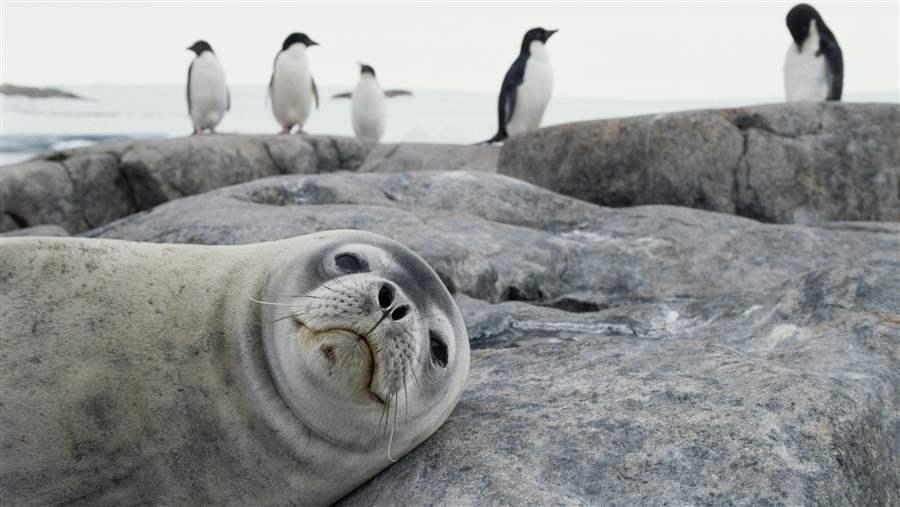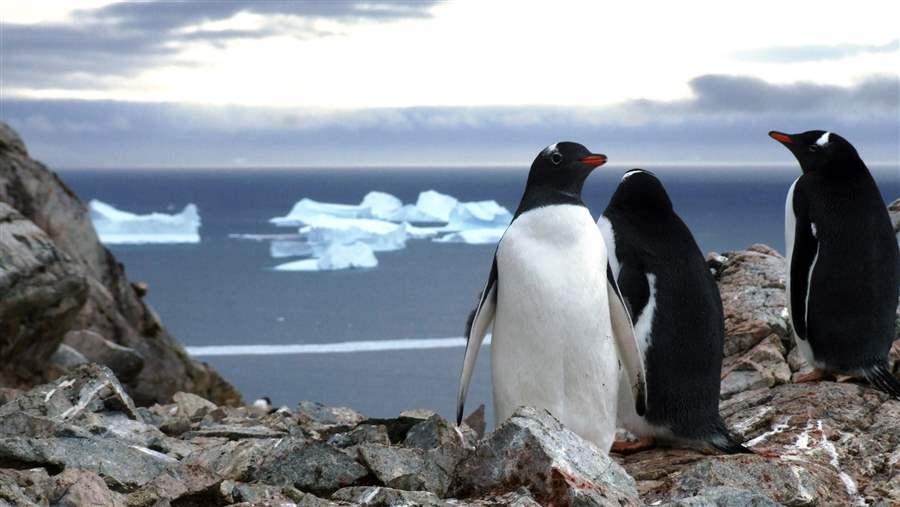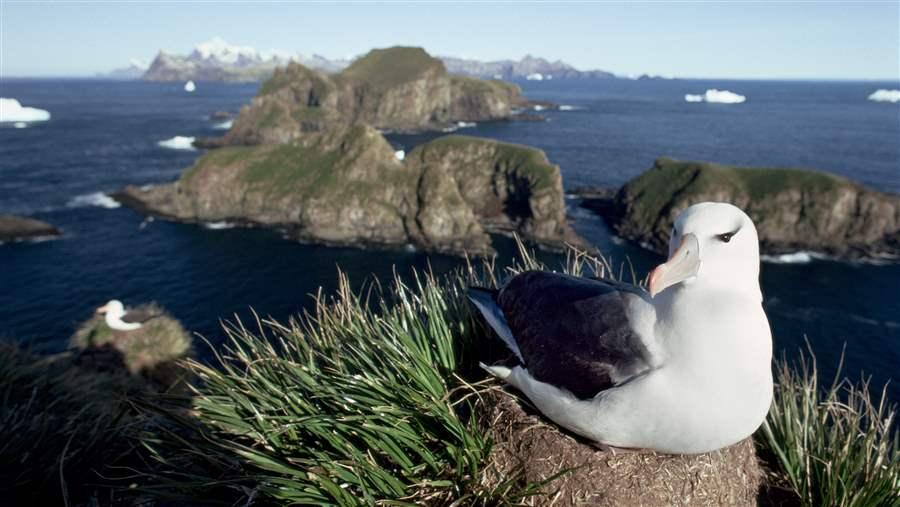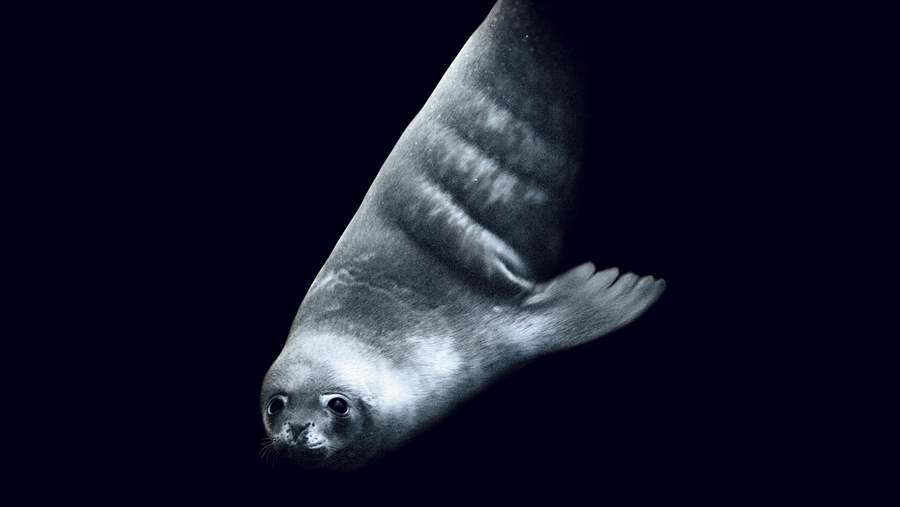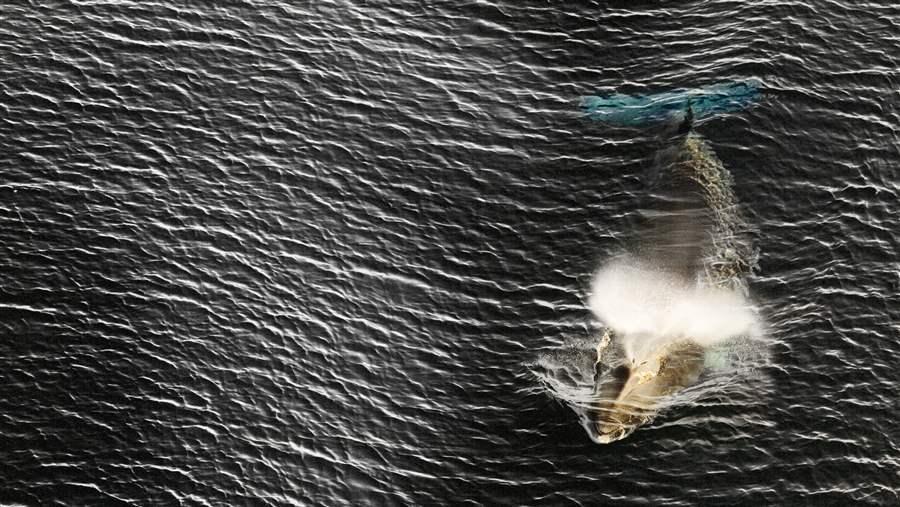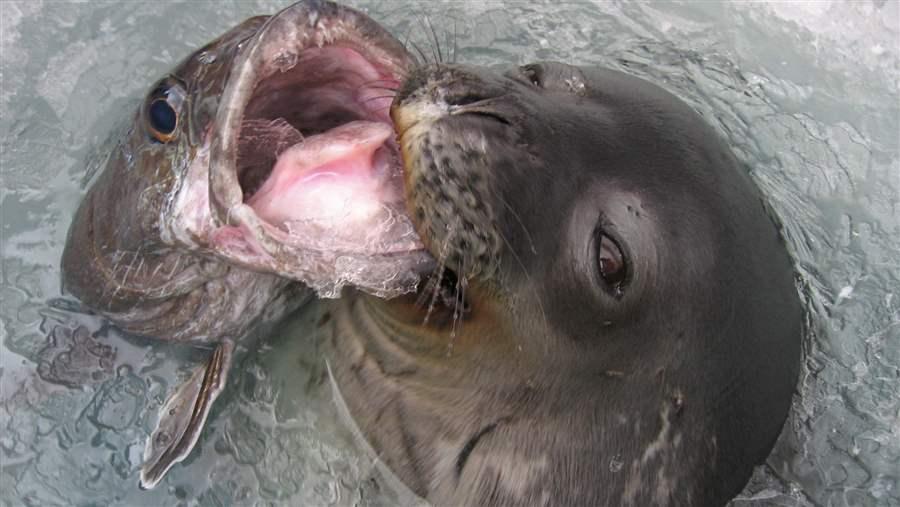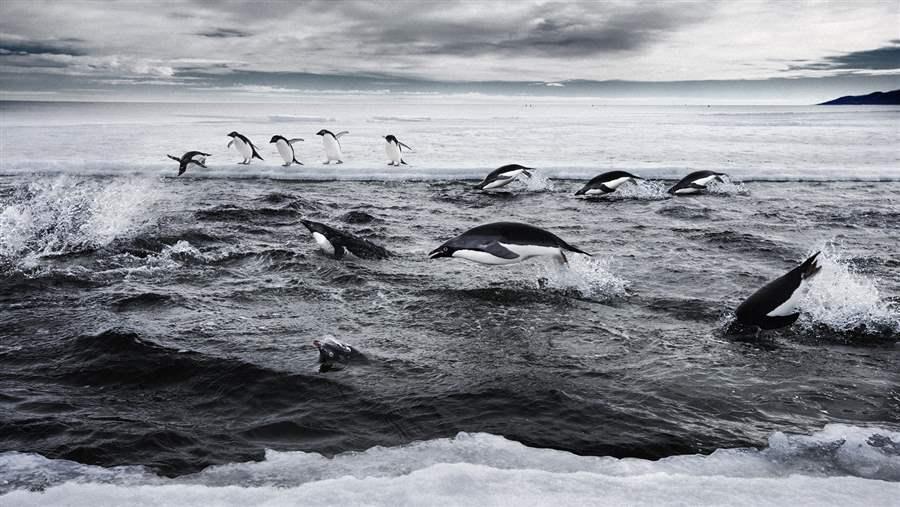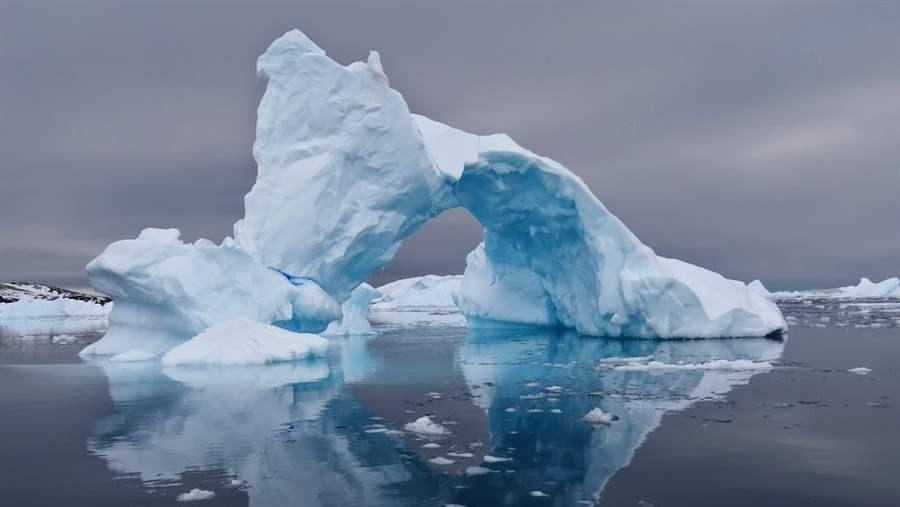南大洋的海洋保护区网络
保护地球上最后一片广阔荒野
概述
环绕南极洲的南大洋是地球上受人类行为影响程度最小的海洋生态系统之一。南大洋面积占世界海洋的 15%,•拥有数千种独特物种,从颜色亮丽的海星、发光的蠕虫到淡色章鱼,多种多样。这里还生活着数百万只•企鹅,它们以数量巨大的磷虾为食。磷虾是一种小型的虾状甲壳类动物,与其他饵料物种一起构成了精巧的食物网的基础。科学家认为,由于受到气候变化的影响,该地区的变暖速度快于地球上任何其他地方,这里的生态系统正在发生改变。
这片海域会产生强大的上升洋流,携带着关键的营养物质流向世界各大洋,因此对于地球的健康状况也至关重要。
为了保护这片独特的区域,皮尤慈善信托基金会 (The Pew Charitable Trusts) 及其合作伙伴与南极海洋生物资源养护委员会 (CCAMLR) 及其成员国政府携手合作,致力于在南极洲建立一个大规模海洋保护区(MPA) 网络。

CCAMLR 建立海洋保护区网络的承诺
CCAMLR 是一个由 24 个国家和欧盟组成的国际机构,成立于 1982 年,主要使命是保护南大洋的多样海洋•生物。虽然 CCAMLR 的优先任务是养护,但是在基于生态系统的管理策略的前提下,CCAMLR 也允许在某些区域进行有限的捕鱼作业。这片水域的主要捕捞对象是犬牙鱼和南极磷虾。- 2002 年,CCAMLR 成为第一家响应联合国世界可持续发展峰会建议,承诺建立 MPA 网络的国际组织。
- CCAMLR 的承诺是建立在其保护(而非开采)南大洋的海洋生物的使命和预防原则(如果已知最佳科学信息有限或不明确之时,则宁可过度养护)之上。
- 2011 年,CCAMLR 达成共识,同意采纳养护措施 91-04,1 ——一个旨在建立海洋保护区网络的框架,并识别出了记案例海洋保护区的九个规划区域2。
减缓和适应气候变化
气候变化对地球的一些最明显的影响,例如暖化和海洋酸化,3 以及海冰密集度和持续时间的变化,4 都已在南极洲出现。研究表明海洋保护区通过消除生态压力,例如捕鱼,可以帮助生态系统建立应对这些变化的适应力。5
- 南大洋相对未受干扰的水域是研究完整海洋生态系统如何对变暖和酸化海洋作出反应的天然实验室。
- 海洋保护区还可以保护重要的碳库或者碳汇(也称为生物储藏库)。全球储藏的生物碳中 55% 以上储存在海洋生物体中。6
超过其他部分的总和
海洋保护区网络不仅保护南大洋诸多独特生态系统之间的联系,使得海洋生物可以在受保护区域之间迁徙, 进行繁殖和觅食,而且还会大大促进全球海洋保护目标的实现。
- 2016 年,养护书信 Conservation Letters 期刊发表了一篇科学评论,文中得出结论说至少 30% 的全球海洋需要划拨到 MPA 中,以实现有效的养护效果以及帮助管理和重新恢复耗尽的鱼类资源。7
- 根据 自然 Nature 期刊 2014 年的一项研究,MPA 要取得成功,应当具备面积庞大、独立、执行良好和持久 的特点,并且应当禁止任何捕捞鱼类或其他资源的行为。8
- 满足上述标准的海洋保护区会形成溢出效应,从而改善受保护区域之外水域海洋生物的健康状况。9
事实:9 个规划区域
区域 1
南极半岛西部和南斯科舍岛弧
超过 150 万对阿德利企鹅、巴布亚企鹅和帽带企鹅生 活在南极半岛。10
区域 2
北斯科舍岛弧,包括南乔治亚和 南桑威奇群岛
这片水域是海洋生物的避难所,这里生活着信天翁、 企鹅、巴塔哥尼亚犬牙鱼、乌贼、灯鱼甚至是章鱼、鲨鱼 以及九种独特的鱼类。11
区域 3
威德尔海
这片地区既有海鸟也有哺乳动物,包括小须鲸、座头 鲸、蓝鲸和长须鲸,12以及威德尔海豹、食蟹海豹和象 海豹。13
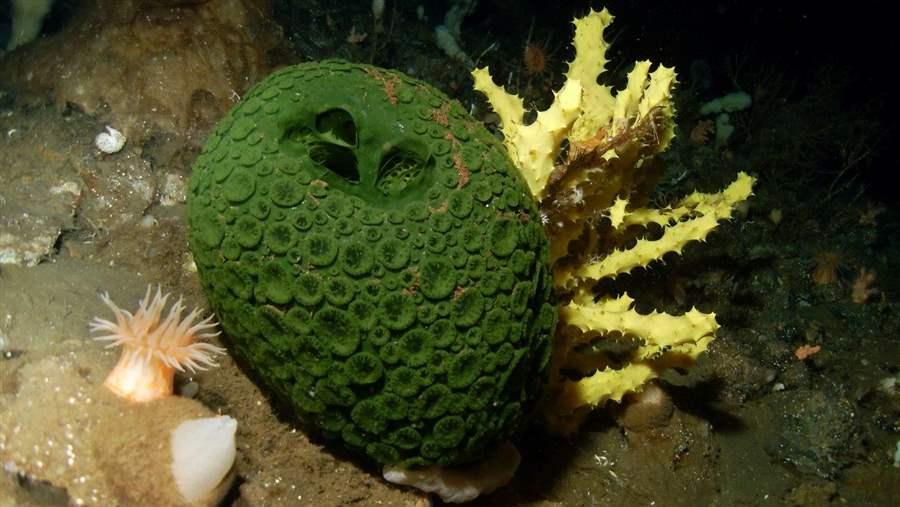
© Steve Rupp/National Science Foundation
区域 4
布韦和毛德海隆
作为世界上最孤立的岛屿,14 布韦岛 (Bouvet Island) 基本上被冰川覆盖,拥有生物丰富的海底,包括海绵、 软体动物、甲壳动物及蠕虫。15
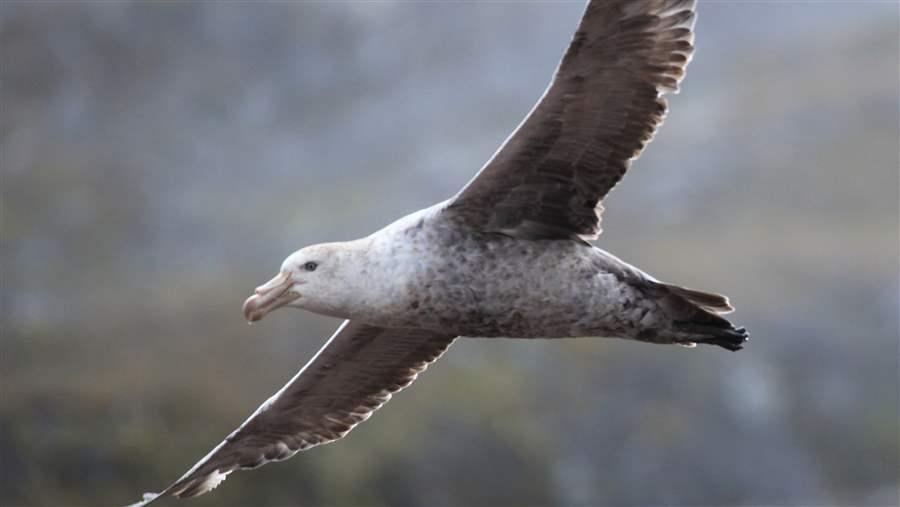
© Liam Quinn
区域 5
克罗泽群岛和德尔卡诺海隆
南极绕极洋流的两个锋之间的漩涡推动了每年的藻华 的形成,16吸引鱼类和乌贼前来,为海鸟和哺乳动物提 供了食物,包括全球数量众多的企鹅繁殖种群;北方 和南方大海燕;白额鹱;漂泊信天翁、乌信天翁、灰背 信天翁;以及濒危灰头信天翁和漂泊信天翁。17
区域 6
克尔格伦高原
克尔格伦生产区 (Kerguelen Production Zone) 位于南 极幅合带与南极绕极洋流之间,是一片开阔水域、富饶 高产,拥有崎岖的深水栖息地,滋养着迁徙经过此区 域的鲸鱼和海鸟,以及大量陆地捕食者,包括繁殖中 的国王企鹅、18南极海狗及象海豹。19
区域 7
东南极
南极洲东部的顶尖捕食者——犬牙鱼会产生自己的 防冻蛋白质,以防血液结晶20并可生长到将近两米长。 最近,科学家发现南极洲东部生活的阿德利企鹅的数 量是之前估计的两倍。21
区域 8
罗斯海
此区域的生物多样性十分显著,包括 150 多种海星 和海胆、其中 40 种均未在地球其他地方出现过;22 小 须鲸;威德尔海豹和豹形海豹;阿德利企鹅和帝企鹅; 及一个基因独特的虎鲸种群,或称杀人鲸,被称为生 态 C 型,习惯以南极犬牙鱼为食。
区域 9
阿蒙森和别林斯高晋海
这片海域有大量海冰覆盖,23因此对于研究人员和渔船 来说,大片区域是难以抵达的。最近一项关于海床群 落的调查发现,该区域 96% 的等足类动物(一种甲壳 动物)在科学上都是新物种。24
展望未来
在日益加剧的环境挑战中,南大洋海洋保护区网络的建立将成为全球环境合作的典范。
2016 年,CCAMLR 在其年会上通过协商一致同意在罗斯海 (Ross Sea) 建立世界上最大的海洋保护区展示了此类合作的范例。罗斯海保护区 206 万平方公里(将近 800,000 平方英里)25面积中包括 155 万平方公里的开放水域,并延伸到罗斯海冰架以下的海岸线。该海洋保护区面积超过法国国土的三倍,已于 2017 年12 月生效。
随着罗斯海保护区的建立,CCAMLR 向建立大规模海洋保护区网络的目标迈出了第一步。朝着这个目标努•力的后续步骤包括通过讨论中的威德尔海和东南极海洋保护区,以及推进南极半岛西部海洋保护区的提案。•还必须进一步努力保护区域 9。
Endnotes
- 南极海洋生物资源养护委员会,“养护措施 91-04:建立 CCAMLR 海洋保护区域的一般框架” (2011), https://www.ccamlr.org/en/measure-91-04-2011。
- 南极海洋生物资源养护委员会,“海洋保护区 (MPA)” ,访问日期:2017 年 3 月 14 日,https://www.ccamlr.org/en/science/ marine-protected-areas-mpas。
- Elizabeth M. Jones 等,“Ocean Acidification and Calcium Carbonate Saturation States in the Coastal Zone of the West Antarctic Peninsula,” Deep Sea Research Part II:Topical Studies in Oceanography (2017), doi:10.1016/j.dsr2.2017.01.007。
- Sharon E. Stammerjohn 等,“Trends in Antarctic Annual Sea Ice Retreat and Advance and Their Relation to El Nino–Southern Oscillation and Southern Annular Mode Variability,” Journal of Geophysical Research 113, no. C3 (2008):C03S90, http://onlinelibrary.wiley.com/doi/10.1029/2007JC004269/abstract。
- 国际海洋考察理事会,“Report of the Study Group on Designing Marine Protected Area Networks in a Changing Climate (SGMPAN)” (2010), https://www.researchgate.net/publication/263888915_Report_of_the_Study_Group_on_Designing_Marine_Protected_Area_Networks_in_a_Changing_Climate_SGMPAN。
- 美国国家海洋和大气管理局,“Marine Protected Areas:Building Resilience to Climate Change Impacts,”访问时间:2017 年 3 月 14 日, http://marineprotectedareas.noaa.gov/pdf/helpful-resources/mpas_climate_change_march_2013.pdf。
- Bethan C. O’Leary 等,“Effective Coverage Targets for Ocean Protection,” letter, Conservation Letters 9, no. 6 (2016):398–404, http://dx.doi.org/10.1111/conl.12247。
- Graham J. Edgar 等,“Global Conservation Outcomes Depend on Marine Protected Areas With Five Key Features,” letter, Nature 506 (2014):216–220, http://dx.doi.org/10.1038/nature13022。
- Callum M. Roberts、Julie P. Hawkins 及 Fiona R. Gell,“The Role of Marine Reserves in Achieving Sustainable Fisheries,” Philosophical Transactions of the Royal Society B:Biological Sciences 360, no. 1453 (2005):123–32, http://dx.doi.org/10.1098/rstb.2004.1578。
- Hugh W. Ducklow 等,“Marine Pelagic Ecosystems:The West Antarctic Peninsula,” Philosophical Transactions of the Royal Society 362, no. 1477 (2007):67–94, http://dx.doi.org/10.1098/rstb.2006.1955。
- 南乔治亚和南桑威奇群岛政府,“South Georgia and the South Sandwich Islands Marine Protected Area Management Plan” (2013), http://www.gov.gs/docsarchive/Environment/Marine%20Protected%20Area/MPA%20Management%20Plan%20v2.0.pdf。
- Campbell R. Davies 和 Nick Gales,“A Brief Review of Sanctuary Theory as It Applies to the Review of the Southern Ocean Sanctuary and the Observed Patterns in Great Whale Populations in the Southern Ocean,” SC/56/SOS2, International Whaling Commission Scientific Committee (2004)。
- Cheryl A. Tosh 等,“Adult Male Southern Elephant Seals From King George Island Utilize the Weddell Sea,” Antarctic Science 21, no. 2 (2009):113–21, https://www.cambridge.org/core/services/aop-cambridge-core/content/view/S0954102008001557。
- Lee Siebert、Tom Simkin 和 Paul Kimberly,Volcanoes of the World, 3rd. ed.(Oakland, California:University of California Press, 2010), http://www.jstor.org/stable/10.1525/j.ctt1pnqdx。
- Angelika Brandt 等,“Maud Rise:A Snapshot Through the Water Column,” Deep Sea Research Part II:Topical Studies in Oceanography 58, no. 19–20 (2011):1962–82, http://www.sciencedirect.com/science/article/pii/S0967064511000609。
- Hugh J. Venables、Raymond T. Pollard 及 Ekaterina E. Popova,“Physical Conditions Controlling the Development of a Regular Phytoplankton Bloom North of the Crozet Plateau, Southern Ocean,” Deep Sea Research Part II:Topical Studies in Oceanography 54, no. 18–20 (2007):1949–65, http://www.sciencedirect.com/science/article/pii/S0967064507001518。
- Amanda T. Lombard 等,“Conserving Pattern and Process in the Southern Ocean:Designing a Marine Protected Area for the Prince Edward Islands,” Antarctic Science 19, no. 1 (2007):39–54, https://www.cambridge.org/core/services/aop-cambridge-core/content/view/S0954102007000077。
- Charles-André Bost 等,“Feeding of Diving Predators and Diel Vertical Migration of Prey:King Penguins’ Diet Versus Trawl Sampling at Kerguelen Islands,” Marine Ecology Progress Series 227 (2002):51–61, http://www.int-res.com/abstracts/meps/v227/p51-61。
- Mary-Anne Lea 等,“Colony-Based Foraging Segregation by Antarctic Fur Seals at the Kerguelen Archipelago,” Marine Ecology Progress Series 358 (2008):273–87, http://www.academia.edu/26554658/Colony-based_foraging_segregation_by_Antarctic_fur_seals_at_the_ Kerguelen_Archipelago。
- Last Ocean Charitable Trust, “Antarctic Toothfish (Dissostichus mawsoni),” accessed 13 February 2017, http://www.lastocean.org/ Commercial-Fishing/About-Toothfish/All-about-Antarctic-toothfish-__I.2445。
- Colin Southwell 等,“Large-Scale Population Assessment Informs Conservation Management for Seabirds in Antarctica and the Southern Ocean:A Case Study of Adélie Penguins,” Global Ecology and Conservation 9 (2017):104–15, http://dx.doi.org/10.1016/j.gecco.2016.12.004。
- Colin Southwell 等,“Large-Scale Population Assessment Informs Conservation Management for Seabirds in Antarctica and the Southern Ocean:A Case Study of Adélie Penguins,” Global Ecology and Conservation 9 (2017):104–15, http://dx.doi.org/10.1016/j.gecco.2016.12.004。
- Janet Bradford-Grieve 和 Graham Fenwick,“A Review of the Current Knowledge Describing the Biodiversity of the Ross Sea Region,” National Institute of Water and Atmospheric Research, prepared for the Ministry of Fisheries Research Project ZBD2000/01 (2001), http://fs.fish.govt.nz/Page.aspx?pk=113&dk=22489。
- Robert L. Pitman 和 Paul Ensor,“Three Forms of Killer Whales (Orcinus orca) in Antarctic Waters,” Journal of Cetacean Research and Management 5, no. 2 (2003):1–9, http://www.heardisland.org/HD_documents/HE_Library/Marinebiology/PitmanandEnsor2003JCRM.pdf。
- Stefanie Kaiser 等,“Biodiversity of an Unknown Antarctic Sea:Assessing Isopod Richness and Abundance in the First Benthic Survey of the Amundsen Continental Shelf,” Marine Biodiversity 39 (2009):27–43, https://link.springer.com/article/10.1007/s12526-009-0004-9。
